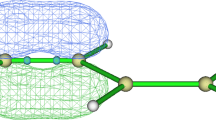The anticommutative Green’s functions of a dimer and its energy spectrum and correlation functions are calculated exactly and in the approximation of static fluctuations within the framework of the Hubbard model. The calculation allows for the interaction of electrons located on different sites. It is shown that this leads to splitting of some energy levels and a substantial restructuring of the energy spectrum of the system.
Similar content being viewed by others
References
J. Hubbard, Proc. Roy. Soc., A276, 238 (1963).
M. C. Gutzwiller, Phys. Rev. Lett, 10, 159 (1963).
J. Kanamori, Prog. Theor. Phys, 30, 275 (1963).
S. P. Schubin and S. V. Wonsowskii, Proc. Roy. Soc., A145, 159 (1934).
S. P. Schubin and S. V. Wonsowskii, Phys. Zs. Sow., 7, 292 (1935).
S. P. Schubin and S. V. Wonsowskii, Phys. Zs. Sow., 10, 348 (1936).
R. H. McKenzie, Comments Cond. Mat. Phys., 18, 309 (1998).
C. E. Campos, Phys. Rev., B-53, 12725 (1996).
A. B. Harris and R. V. Lange, Phys. Rev, 157, 156 (1967).
F. Castet, A. Fritsch, and L. Ducasse, J. Phys. I (France), 6, 583 (1996).
L.Ducasse, J. Phys., 21, 115 (2000).
B. Alvarez-Fernandez and J. A. Blanco, Eur. J. Phys, 23, 11 (2002).
E. J. Meniry, Introduction to the Hubbard Model, University of Belfast (2005).
A. V. Silant’ev, Izv. Vyssh. Uchebn. Zaved. Povolzhskii Region. Fiz.-Mat. Nauki, No. 3(19), 151 (2011).
A. V. Silant’ev, Izv. Vyssh. Uchebn. Zaved. Povolzhskii Region. Fiz.-Mat. Nauki, No. 4(20), 122 (2011).
A. V. Silant’ev, Izv. Vyssh. Uchebn. Zaved. Povolzhskii Region. Fiz.-Mat. Nauki, No. 4(24), 214 (2012).
A. V. Silant’ev, Russ. Phys. J., 56, No. 2, 192 (2013).
G. I. Mironov, Fiz. Tverd. Tela, 49, 527 (2007).
R. R. Nigmatullin, A. A. Khamzin, and I. I. Popov, Zh. Eksp. Teor. Fiz., 114, 355 (2012).
G. I. Mironov, Fiz. Tverd. Tela, 48, 48, 1299 (2006).
A. I. Murzashev, Zh. Eksp. Teor. Fiz., 135, 122 (2009).
S. V. Tyablikov, Methods of the Quantum Theory of Magnetism [in Russian], Nauka, Moscow (1975).
F. Gebhard, The Mott Metal-Insulator Transition: Models and Methods, Springer-Verlag, Berlin (1997).
Author information
Authors and Affiliations
Corresponding author
Additional information
Translated from Izvestiya Vysshikh Uchebnykh Zavedenii, Fizika, No. 11, pp. 37–45, November, 2014.
Rights and permissions
About this article
Cite this article
Silant’ev, A.V. A Dimer in the Extended Hubbard Model. Russ Phys J 57, 1491–1502 (2015). https://doi.org/10.1007/s11182-015-0406-z
Received:
Published:
Issue Date:
DOI: https://doi.org/10.1007/s11182-015-0406-z




